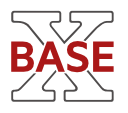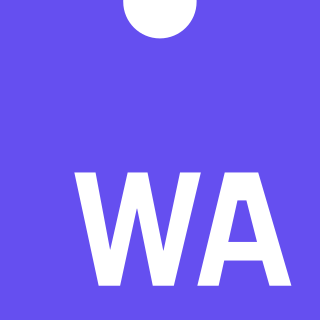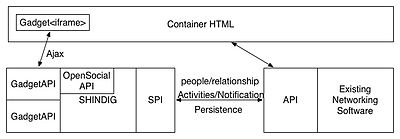Google Developers is Google's site for software development tools and platforms, application programming interfaces (APIs), and technical resources. The site contains documentation on using Google developer tools and APIs—including discussion groups and blogs for developers using Google's developer products.

HTML5 is a markup language used for structuring and presenting hypertext documents on the World Wide Web. It was the fifth and final major HTML version that is now a retired World Wide Web Consortium (W3C) recommendation. The current specification is known as the HTML Living Standard. It is maintained by the Web Hypertext Application Technology Working Group (WHATWG), a consortium of the major browser vendors.
The Sun Java System Portal Server is a component of the Sun Java Platform, Enterprise Edition, a software system that supports a wide range of enterprise computing needs.
OAuth is an open standard for access delegation, commonly used as a way for internet users to grant websites or applications access to their information on other websites but without giving them the passwords. This mechanism is used by companies such as Amazon, Google, Meta Platforms, Microsoft, and Twitter to permit users to share information about their accounts with third-party applications or websites.
A software widget is a relatively simple and easy-to-use software application or component made for one or more different software platforms.
WebRTC is a free and open-source project providing web browsers and mobile applications with real-time communication (RTC) via application programming interfaces (APIs). It allows audio and video communication and streaming to work inside web pages by allowing direct peer-to-peer communication, eliminating the need to install plugins or download native apps.

BaseX is a native and light-weight XML database management system and XQuery processor, developed as a community project on GitHub. It is specialized in storing, querying, and visualizing large XML documents and collections. BaseX is platform-independent and distributed under the BSD-3-Clause license.
Content Security Policy (CSP) is a computer security standard introduced to prevent cross-site scripting (XSS), clickjacking and other code injection attacks resulting from execution of malicious content in the trusted web page context. It is a Candidate Recommendation of the W3C working group on Web Application Security, widely supported by modern web browsers. CSP provides a standard method for website owners to declare approved origins of content that browsers should be allowed to load on that website—covered types are JavaScript, CSS, HTML frames, web workers, fonts, images, embeddable objects such as Java applets, ActiveX, audio and video files, and other HTML5 features.
HTML audio is a subject of the HTML specification, incorporating audio input, playback, and synthesis, all in the browser.
User-Managed Access (UMA) is an OAuth-based access management protocol standard for party-to-party authorization. Version 1.0 of the standard was approved by the Kantara Initiative on March 23, 2015.
Distributed social network projects generally develop software, protocols, or both.
Google APIs are application programming interfaces (APIs) developed by Google which allow communication with Google Services and their integration to other services. Examples of these include Search, Gmail, Translate or Google Maps. Third-party apps can use these APIs to take advantage of or extend the functionality of the existing services.
The OpenAPI Specification, previously known as the Swagger Specification, is a specification for a machine-readable interface definition language for describing, producing, consuming and visualizing web services. Previously part of the Swagger framework, it became a separate project in 2015, overseen by the OpenAPI Initiative, an open-source collaboration project of the Linux Foundation.
Media Source Extensions (MSE) is a W3C specification that allows JavaScript to send byte streams to media codecs within web browsers that support HTML video and audio. Among other possible uses, this allows the implementation of client-side prefetching and buffering code for streaming media entirely in JavaScript. It is compatible with, but should not be confused with, the Encrypted Media Extensions (EME) specification, and neither requires the use of the other, although many EME implementations are only capable of decrypting media data provided via MSE.
Brotli is a lossless data compression algorithm developed by Google. It uses a combination of the general-purpose LZ77 lossless compression algorithm, Huffman coding and 2nd-order context modelling. Brotli is primarily used by web servers and content delivery networks to compress HTTP content, making internet websites load faster. A successor to gzip, it is supported by all major web browsers and has become increasingly popular, as it provides better compression than gzip.
Universal 2nd Factor (U2F) is an open standard that strengthens and simplifies two-factor authentication (2FA) using specialized Universal Serial Bus (USB) or near-field communication (NFC) devices based on similar security technology found in smart cards. It is succeeded by the FIDO2 Project, which includes the W3C Web Authentication (WebAuthn) standard and the FIDO Alliance's Client to Authenticator Protocol 2 (CTAP2).

WebAssembly defines a portable binary-code format and a corresponding text format for executable programs as well as software interfaces for facilitating interactions between such programs and their host environment.
WebXR Device API is a Web application programming interface (API) that describes support for accessing augmented reality and virtual reality devices, such as the HTC Vive, Oculus Rift, Oculus Quest, Google Cardboard, HoloLens, Apple Vision Pro, Magic Leap or Open Source Virtual Reality (OSVR), in a web browser. The WebXR Device API and related APIs are standards defined by W3C groups, the Immersive Web Community Group and Immersive Web Working Group. While the Community Group works on the proposals in the incubation period, the Working Group defines the final web specifications to be implemented by the browsers.

A well-known URI is a Uniform Resource Identifier for URL path prefixes that start with /.well-known/. They are implemented in webservers so that requests to the servers for well-known services or information are available at URLs consistent well-known locations across servers.





